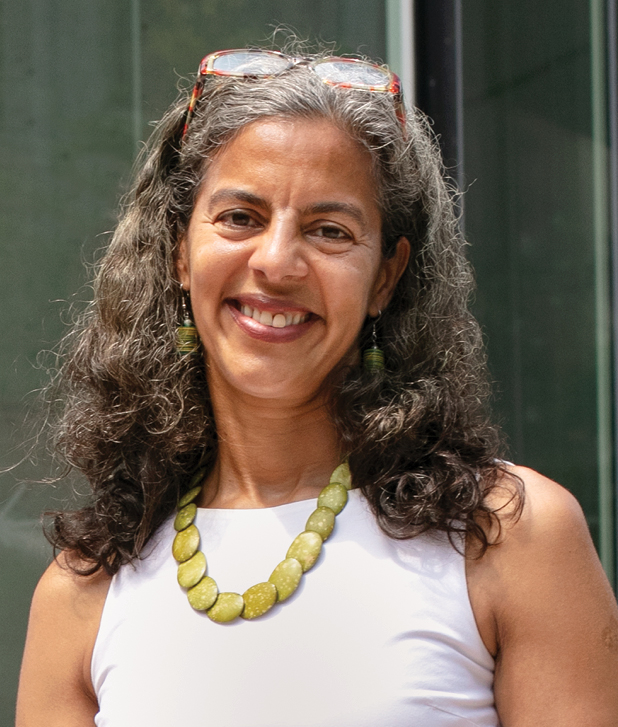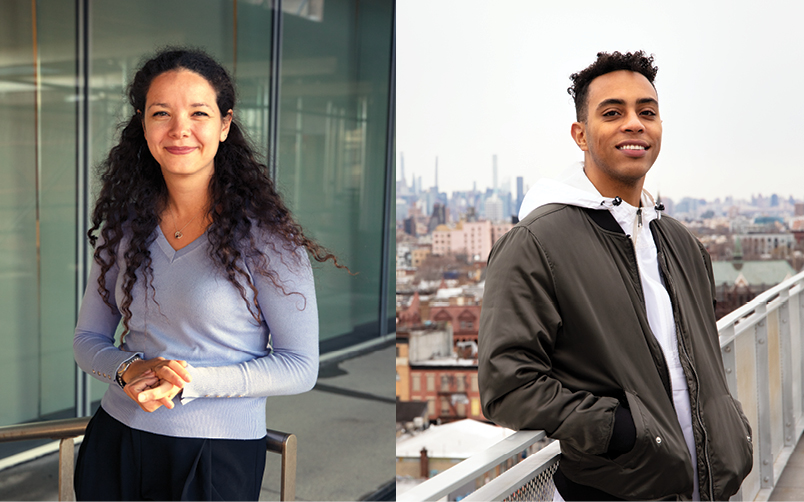Building a More Inclusive Environment Through Education
When Hetty Cunningham, MD, joined the Columbia faculty more than 20 years ago as an attending physician, she noted that residents did not consistently use interpreters for Spanish-speaking patients.
“I noticed that with very limited Spanish-speaking skills, residents were missing so much richness in terms of the patients’ lives, and of course quality of care would suffer,” she says. “Not only that, but their interest in the patients and their joy in practicing medicine were significantly decreased.”
 Hetty Cunningham.
Hetty Cunningham.In an effort to improve patient outcomes, Dr. Cunningham began advocating for residents to make better use of the hospital’s volunteer interpreter service corps. Then she lent her talents to programs that promote more empathetic communication with patients, build cultural competency, and address health disparities in people of color. Those 20-plus years put her at the forefront of anti-racism work in medicine before it was elevated to a mainstream goal in recent years.
“This anti-racism work that we’re doing now has gone by many different names over time—cultural competency, implicit bias—and the foci have changed over time, too, but the emphasis on equity and the passion for the work remain the same,” she says.
Today, as director of equity and justice in curricular affairs at VP&S, Dr. Cunningham oversees the VP&S Equity and Justice Fellowship. In 2020, the combination of the COVID-19 pandemic and the Black Lives Matter movement helped raise awareness of anti-racism work, particularly in health care settings.
“COVID made health disparities more apparent than they had been in 20 years, and at the same time the Black Lives Matter movement really began to crystallize everyone’s awareness of these issues,” Dr. Cunningham says. “At the same time, many students were asking for more anti-racism programming in the curriculum.”
The fellowship grew out of work students were already doing to support anti-racist curricula and was endorsed by medical center and VP&S task forces established to recommend ways to build a more inclusive learning, research, and patient care environment at the medical center.
The VP&S Equity and Justice Fellowship formally gives voice to students leading anti-racism efforts. The fellowship’s goal is to improve curricular programming by applying an anti-racist lens to the VP&S curriculum.
Each year, the fellows work alongside Dr. Cunningham on a collection of shared efforts and individual projects. In 2021, the second class of fellows worked on developing longitudinal anti-racism threads for the Foundations of Clinical Medicine pre-clinical course, helped with the inaugural Anti-Racism Curriculum Summit, and collaborated with faculty to evaluate equity in medical student grading.
Laura Benoit, an MD/PhD student who was in the first class of fellows, helped create the first VP&S Guidelines for Promoting a Bias-free Curriculum in 2017. Joining the fellowship gave her the opportunity to aggregate student feedback and adjust the guidelines as needed.
Dr. Benoit’s efforts began in 2015, when she and her classmates began their own anti-racism work within VP&S as first-year medical students.
“As first-years, we were often confused or frustrated by the content in our classes,” she recalls. “Sometimes lecturers would say things, and it would seem off somehow, even if we didn’t exactly know how.”
One example occurred during the first-year anatomy course, in which lecture materials about the oral cavity described healthy gums as coral pink. “Some of us in the class heard that and started looking around at each other, thinking, ‘That’s not true for everybody. Something is missing here,’” Dr. Benoit says.
The students brought the issue to the instructor’s attention, citing that healthy gums in a person of color may not be pink at all. The professor was receptive to their feedback and revised the materials; she also encouraged the students to use the example in discussions with faculty about revisions to the curriculum.
“Bias in the curriculum may not always be caused by overt racism, but it can still result in ill-taught physicians,” Dr. Benoit says. “That’s very clear from the amount of bias in medical providers, which results in worse outcomes for patients.”
“It’s become more acceptable to just say this out loud; systemic racism is real so let’s just dive in.”
In another instance, a genetics professor was describing genetic testing for cystic fibrosis and other genetic disorders. The professor noted the discrepancy in the tests’ accuracy across racial backgrounds but did not elaborate on why those discrepancies exist. Students in the class asked for more context, prompting a discussion about the history of research funding for certain genetic disorders and how that history might explain the disparities in testing efficacy among different races.
“I think we were just pushing for those kinds of experiences in the classroom. We were pushing for more transparency, open communication, and context,” Dr. Benoit recalls. “We realize that our professors don’t know everything, but they should know more than we do, and we want to be given the proper context so that we can avoid some of these common pitfalls that we may fall into.”
Conversations among Dr. Benoit and other students led to the creation of the VP&S Task Force for a Bias-Free Curriculum, which ultimately produced the VP&S Guidelines for Promoting a Bias-Free Curriculum. The guidelines, which were adopted by the Committee on Education Policy and Curriculum in 2017, provide educators with a toolkit for combating systemic racism and weeding out bias in the curriculum. They include a feedback portal for students to provide additional feedback for faculty.
The guidelines were met with enthusiasm and published in Academic Medicine, the peer-reviewed journal of the Association of American Medical Colleges. Dr. Cunningham cites the group’s publication as exemplary anti-racist work and notes that the guidelines have become a national model for other medical schools and academic medical centers. But when the task force’s work began drawing to a close in 2018, Dr. Benoit and her peers still didn’t feel their work was finished.
“On that task force, I got to spend a lot of time with Dr. Cunningham, and she always had a lot of ideas about where to go next. We wanted to keep going,” Dr. Benoit says. The VP&S Equity and Justice Fellowship provided the platform the group needed.
The fellowship has provided a space to build upon the group’s work by revising the guidelines and taking in new feedback, providing improved resources and support, and finding avenues for continuing dialogue between faculty and students.
“The idea with the guidelines was always for them to be a living and breathing document,” says Dr. Benoit. “In that regard, the VP&S Equity & Justice Fellowship has provided a really helpful space for iterative self-reflection.”
During her six years on campus, Dr. Benoit says that she has witnessed positive change at VP&S, not only in the curriculum, but also in the culture and in the community’s ability to address bias within the institution.
“Especially in the early going, there was a lot of hesitation around this work,” she recalls. “People would say, ‘We don’t want to ruffle too many feathers here. We don’t want to be too blatant.’ But that’s changed a lot.
“Revamping the guidelines included them being more explicit, more direct than we had been before. It’s become more acceptable to just say this out loud; systemic racism is real so let’s just dive in.”
The fellowship also creates space for individual projects, which fellows decide with Dr. Cunningham’s input and pursue during their time at VP&S. Ahmed Owda’22, a fellow in the second class, has dedicated his time to creating an oral history of race and racism at VP&S.
 Laura Benoit and Ahmed Owda
Laura Benoit and Ahmed Owda“I am trying to document this narrative from the school’s founding to the present day,” he says of the project. “A fair amount of people here now know the history of Dr. Samuel Bard—a founding member of the medical school, George Washington’s physician, and a slave owner. But between the school’s founding and up to the last 20 to 30 years of progress, there’s a very long history there that needs to be explored.
“For much of American history, medicine in general has been, overall, a very racist institution. Columbia is a preeminent leader in medicine, and we need to acknowledge its place in that history.”
Dr. Owda’s goal is to tell the entire story, from the beginning of VP&S up to 2020, when the school announced its blueprint for becoming a fully anti-racist medical school.
“I would like to create this lecture and have it presented to students, ideally in their first year. I think it’s important to give them that context and hopefully empower them to do something with it,” he says. “We’re only here for a short period of time, so the question is, what do you want to do with the four years you’ll spend here?”
Dr. Owda, who was born in England but is of Sudanese descent, grew up near Flint, Michigan. Health disparities among people of color were a primary motivator on his journey to becoming a doctor. A self-described history nerd, he advocates for physicians’ broader understanding of historical inequities between racial groups.
“When you really try to unpack racism, you realize that science can only take you so far. We have to think outside of the box—outside of our hospitals and health care settings—if we’re going to right these wrongs.”
Within the fellowship cohort, he has discovered a greater appreciation for what it takes to effect change at the institutional level, and he hopes that the fellowship’s work will inspire lasting growth at VP&S and beyond.
“It’s great that we’re doing this work as students, but we can only do so much. I hope that this fellowship will help create the next generation of medical school faculty who will continue that work,” he says.
“The fellowship has inspired me to potentially pursue a more academic path, because I see real change happening in medical education. There’s real power among medical faculty, especially in making change and dictating what medicine is and how it serves people.”
Dr. Cunningham shares those aspirations for the future of the program. Though the fellowship is still in its infancy—it will welcome its third cohort this year—she hopes to expand its reach to all four schools at the medical center.
“I would like to help create the next generation of leaders in this space. I’d like to train these fellows to be leaders in this work in medical education,” she says. “I’d also like to broaden the fellowship to serve more students, to really bring a wider group of students together around this cause.”
VP&S is among 11 medical schools selected to participate in the Anti-Racist Transformation (ART) in Medical Education project. As director of equity and justice in curricular affairs at VP&S, Hetty Cunningham, MD, will co-lead the project at Columbia with Jean-Marie Alves-Bradford, MD, founding director of the Department of Psychiatry’s Office of Equity, Diversity and Inclusion. ART seeks to replicate a model originally developed by the Icahn School of Medicine to dismantle systemic racism and bias in work and learning environments.
More VP&S anti-racism education resources can be found at
vagelos.columbia.edu/education/
academic-programs/md-program/about-md-program/anti-racism-resources.
She also hopes for continued and expanded support from fellow medical center faculty members, ideally leveraging their expertise to create more inclusive curricular programming.
“I think a lot of faculty feel bad, or they feel ashamed in this space. To them, this anti-racism work can feel like a critique,” she says. “But I think it’s really important to note that our faculty have been doing this work all along. It’s what they do: They get up every day, they go into the hospital, and they care for vulnerable populations. These are people who could work anywhere in the world, and they’re right here in Washington Heights, in Harlem, serving these populations. They are doing anti-racist work every single day. This programming simply helps us do it even better.”
- Log in to post comments


